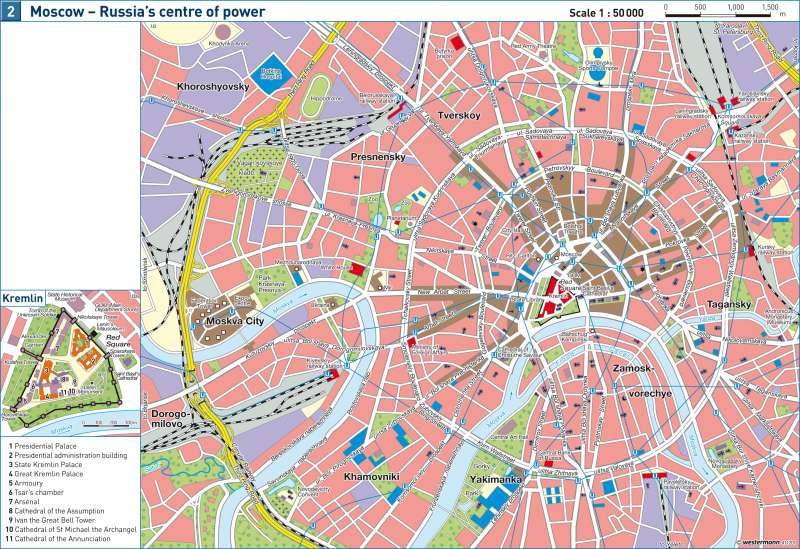Moscow — Russia's centre of power
Russia
978-3-14-100790-9 | Page 84 | Ill. 2

Information
The map of the city shows the radial-circular base structure within the so-called "Garden Ring" and the functional structures.Urban Development
The earliest detailed accounts of Moscow, was that of Baron von Herberstein in the 16th Century, who aptly characterised the city as "Russia's main and centre." This central position is reflected today in the star-shaped tapering to the Kremlin radial roads. They are far older than those from the 16th Century ring roads and they help to understand the rapid growth of the 1147 settlements as mentioned in writing. During the Middle Ages, these roads led to all cardinal points and regions with different bio-physical facilities, economic suitability and development levels. The economic and military activities in the surrounding areas were taking place in no small part on these roads and influenced the fate of the city.
The Arbat was the main trade route to the west, through Smolensk, on to Poland and then to central Europe. Its Arabic name was kept, it now stands, however, for the modern residential and business streets of Moscow. The Tver Street led to Novgorod in the commercial area of the Hanseatic League. It was renamed Gorky Street in 1935 and was a model for many avenues in the "socialist cities" of the Stalin era. To the north, major trade routes were established in the upper Volga and in the early industrial area around the Trinity Monastery. The Ordynska road linked Moscow with the fertile forest-steppe country of the south, whose crops and cattle pastures contributed significantly to the nourishment of the city. The road also followed the direction and reached the lands around Moscow from which came the punitive expeditions of the Tatars came.
By the mid-19th Century railroads began on these main routes. This developed Moscow into the large traffic and transport centre, first of Eastern Europe, later the Soviet Union and finally, Russia, after its collapse. Here, nine terminus stations meet with 11 railway lines. Air traffic at four airports connect the city with the rest of the country. The main destination of international flights is Sheremetyevo Airport. The Moscow-Volga Canal links the city to the eastern waterways.
Moscow is the most important industrial city in Eastern Europe with a focus on machinery and consumer goods industry. In December 1991, the collapse of the Soviet Union meant that, Moscow lost its function as the capital for the entire former Soviet Union. Nowadays, Moscow is only known as the capital of Russia.
Although Moscow had to concede its role as seat of the Imperial Court (1712 to 1918) to Saint Petersburg, the city is as a prime example of the "capital syndrome", according to which the thinking and lifestyle of an era in a capital expresses and radiates from there to the entire country. Also, the change of regime in the early 1990s, has been quick to leave its mark in the city, such as in the rapidly expanding retail market.
A. Karger; Ü: C. Fleming




